Varanasi Warning: We saw some pretty intense stuff here. I write about it because this is our experience, but the detail included might be too much for some. Of course I was respectful when taking photos so all are appropriate; some may prefer to look rather than read!
Friday, Feb. 28, 2014
We arrived in Varanasi via our overnight train at about 9:30 a.m. The weather reminded us of Seattle; wet, dark and only promises of more of the same to come the next 24 hours. My vision of a brightly colored pastel wonderland amplified by a brilliant amber sun igniting the holy Ganges River quickly evaporated.
The four of us went to the pre-paid autorickshaw stand to attempt to salvage some of our backpacking dignity and not get completely ripped off. For less than 100 rupees we got two rickshaws to take us the 2 km distance towards the Vishawanath Temple.
The rickshaw dumped us on the side of the sewage muddy road. Knowing we would be completely lost in the feces maze of the Old Town, we trustingly followed the first young lad that offered to escort us to Teerth Guesthouse.
We had previously booked a hostel, but decided realistically if we could score our own room for the same price it would be a better deal, so we tagged along with Kelly and Tanveer to try to get a room at Teerth.
We found Teerth and it was an absolute chaotic nuthouse so we all quickly dropped our bags and went to a recommended place to eat. We ended up at Ganga Fuji. The food was spicy, piping hot and disappeared within seconds.
After lunch Kelly and Tanveer were rightfully pooped and James and I were ready to stretch our legs and explore. We reentered the courtyard of Teerth and it still looked like a natural disaster shelter. There were 150 Indian people with mattresses and newspapers strewn across every used-to-be-white tile. Buckets of fried dal were being passed out and people were digging in with their hands. Since the spiderweb-like streets of Varanasi are also frequented by more cows than the 1.2 million people that call the heart of Hindu city home, there are massive cow pies dotting every other meter of the streets. Of course, with over one hundred barefoot Teerth guests walking up and down these streets going to and from the many ghats, that also meant they were tracking a ton of crap back into the courtyard of Teerth.
Yummy.
James and I walked in and were shown our room. There were 20 people that we had to step over in order to get to the door and for 800 rupees we both silently agreed to move on.
Later, poop palace.
We blindly headed into the wet poopey alleys and jumped into the stream of shuffling people to search for a new home. A colorful painted sign for Ganpathi Guesthousedecorated a clean slab of bricks so we showed up and asked for a room.
The only room they had was about 400 rupees beyond budget, but once we were shown the room I think we both silently argued the root of the word budget was budge, meaning we should freaking give in and indulge in the luxurious place. Knowing we should be realistic, we politely declined and decided to at least check out the dorm at the hostel near Munshi Ghat we originally booked.
Thanks only to the direct access staircase from Ganpathi, we found the Ganga River and I felt like I could breathe. Something about just seeing water makes me so happy these days.
We walked 30 minutes before realizing we walked about 15 minutes too far south. Thunder cracked overhead and immediately we knew we were doomed. Rain drops came down without much more warning and we quickly sprinted back toward Ganpathi.
With passports, cameras, computers, iPhones and iPads all in our small backpacks that were quickly getting drenched, we had to pull over into any cover we could find. This was unfortunate for the poor man trying to bathe in the four foot patio thing he called home, because a soaking wet pissed off white couple showed up uninvited. He didn’t really seem to mind and within 30 minutes the rain allowed us to move on.
It was getting late and we were sick of searching and being homeless, soggy and hungry. We ended up unenthusiastically deciding to settle at the poop palace. We walked back in and it was before James even had his second foot in the door when I heard him probably too loudly call it Hotel Rwanda.
Okay, that’s it. Back to Ganpathi we go.
Ganpathi reception laughed when they saw us for the 3rd time at 4:30 p.m. and we finally forked over the cash and passports in exchange for a Ganesh key and lock. It was the cleanest, sweetest room we have had in India and dang was it worth every $3.50 I have.
We settled into our room and then headed out to explore Varanasi. We decided we had seen enough of the poopey streets and instead went straight to the river. We walked into Meer Ghat and then further down to Man Mandir Ghat.
It only took 10 minutes to reach the liveliest main ghat, Dasaswamedh Ghat. This was the spot with supposedly the most action so we stuck around and watched the many boats come and go, people selling flowers, babas meditating and praying, people smoking, doing some form of yoga, kids pooping, monkeys playing, cows pretending to graze, dogs scratching and women begging.


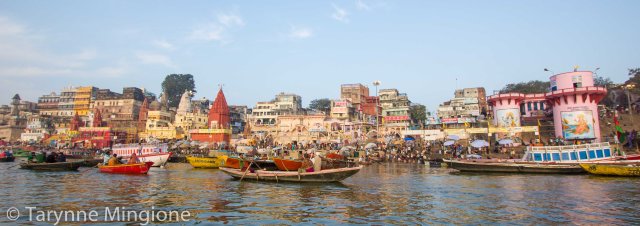

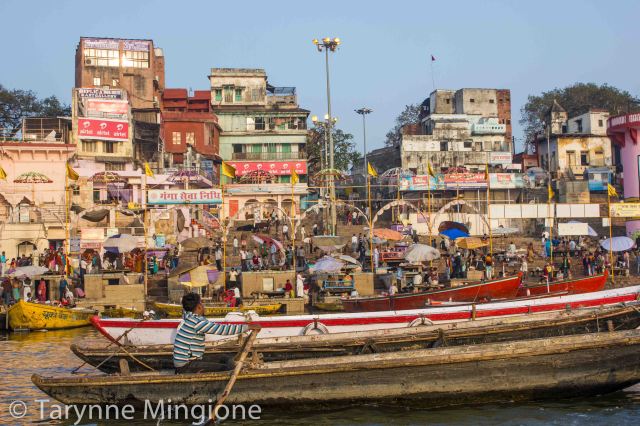


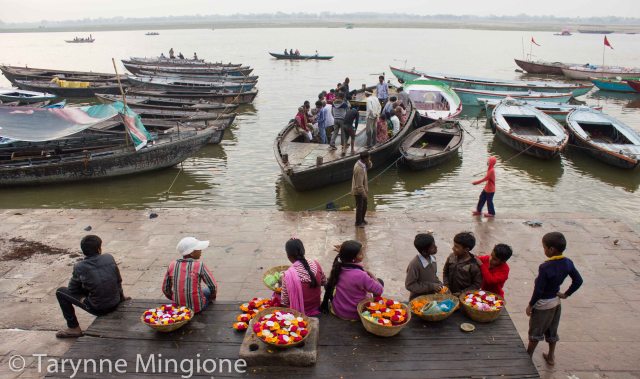



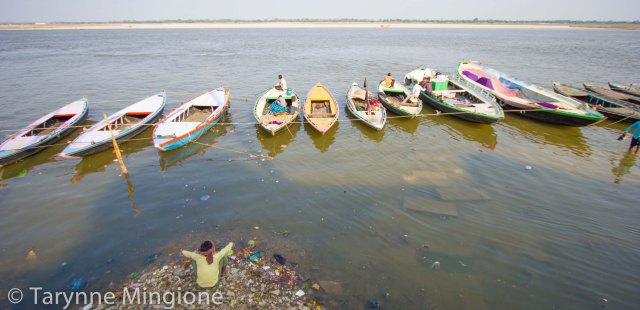







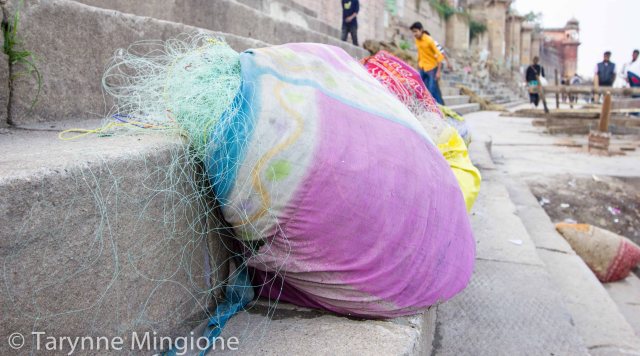




It was getting dark, but this was the safest place in India so we freely decided to roam further down (up) the river.
We passed the red and yellow alternating steps of the colorful Munshi Ghat before we saw the most culturally shocking scene we have witnessed so far on this trip.
We arrived at Harishchandra Ghat. This ghat is a smaller burning ghat, secondary to the main burning ghat of Manikarnika. I’m completely naïve and thought since it was rumored as the “smaller” burning ghat that perhaps we would passby and not see anything.
Wrong.
We were forced to walk through the drifting black smoke from a nearby fire and my breath was taken away in a manner I have been fortunate to never experience. The smell of burning skin and hair made my heart sink to my stomach, or the other way around; I’m not exactly sure how to explain it.
You know when you are viewing a scary movie and you want to watch but really don’t? It was exactly that. I looked at the fire and saw a young mans head and feet extending out from the flames.
I’ve never seen a human body cremated before. Maybe I’m an idiot, but I guess I never thought about the actual process, just the yielding product.
We carried on walking up the river down to Jain Ghat before turning around and heading back as it was already completely dark. We re-approached the Harishchandra Ghat and walked once again through the intense smoke to get to the clear air on the opposite side.
We hadn’t asked the locals many questions, including what was appropriate for a tourist to watch or not watch and felt uncomfortable stepping onto the concrete viewpoint that overlooked the burning tiers.
A man that has worked at the burning ghat for years came up and offered us valuable information in exchange for a couple hundred rupees. I felt completely relieved to be able to unembarrasingly ask questions and get answers that would help me stay respectful at such a place as this.
He informed us that it was okay to watch, but that a woman was never allowed in the center where the burning occurs. Obviously no pictures can be taken, but otherwise foreigners are allowed to respectfully and quietly watch.
Like I said, this information might be a bit too much for some. James and I saw about four fires happening.
Kids that were probably seven and eight years old had large bamboo sticks and they continued to poke fires. James and I wondered if those fires were about to receive or had already burned bodies. We got our answer when I asked what the charred block of something was that was picked out of the amber flames by the small boy.
That, said Roj (the man that was sticking by our side offering information), is the sternum of the man that was just burned in that fire. Half in disbelief we watched the boy go to the river bank and throw the burned bones into the river; coming so close to a passing tourist boat that everyone in the boat got soaked with splashing water from the Ganga River.
Moments later we watched a body being carried down from the steps on a bamboo stretcher dressed in a white cloth. Roj informed us it was a young man that had died. Red cloth is used for a young woman, and gold is used for older men and women. Brightly colored dressings and strands of flowers are laid upon the corpses. The bodies are then laid on bamboo stretchers and friends and family carry the stretchers down to the river.
The body is laid in the river while the wood is weighed, purchased and the fire is constructed. Only disease and natural cause deaths are allowed to be cremated. If it is suicide, an accident, or a pregnant woman, the body is strapped to a stone slab and taken to the middle of the river and thrown into the Ganga.
We watched the boy’s body hastily placed halfway in the river and left to sit while young men stacked logs in a ladder-like fashion just two meters from the river.
There are three locations for fires that are congruent with the caste system. The bottom (closest to the water) supposedly was about 5,000 rupees, middle tier was 10,000 and very important and rich people were cremated in an elevated circular stone slab for about 15,000 rupees.
Sandalwood is the most expensive wood as it produces the sweetest smell. It costs about 300 rupees for just one kilo of wood. The fire was built and lit. Dressings and flowers were carelessly removed and thrown on the ground. The seven year old boy in barefeet came over and picked through the discarded items and clutched them close to his chest as he made his way back up to the busy street. What he does with them from there I am not sure.
The body was thrown onto the stack of logs. (I’m not being careless with my word choice, rather using the correct verb to explain how things were handled.) Logs were forcefully placed on top of the body. Minutes later thick horrific smoke was released from the body. Three hours later the only thing remaining would be the charred thoracic cavity that would then be thrown into the river.
James and I watched and I can’t say how lucky I was to have my best friend at my side to watch something like this. It’s interesting to hear your own words released from your mouth as you watch something as real as this. It’s intense. As you watch fire after fire and body after body being carried by the people that played a role in the life of the now lifeless person, it is just incredible to really think about life, death, spirituality, religion, humanity and reality.
Varanasi sums it up: I love India because it openly accepts reality. India also scares the hell out of me because it does it so unapologetically and indiscreetly, rapidly exposing you to all of those things you so often chose not to think about.
One thing that surprised me was how emotionless and unattached the whole process appeared. I can’t say I even can begin to understand their culture or what it would be like to have a life any other than my own, all I am saying is my impression from a viewers perspective is it was shocking at how dry the whole thing was. I couldn’t imagine being in the mens’ shoes and knowing the person that once owned the physical body they were carrying and then burning.
Death is crazy. Varanasi doesn’t give you an option but to think about it in a way I never have before.
Standing there with it all happening was intense, to say the least.
We were told about the holy fire that is 600 years old and burns constantly. It is just near the entrance to the crazy busy streets up the stairs from the ghat. We decided to take a peek up there.
As we walked in from the small jetty I stopped to watch one of the fires. I turned around probably a minute too late. James had already stepped to the side and I quickly followed.
Two frail men were carrying a stretcher down the steps. Unable to carry the weight of the body in the stretcher the two men dropped the body about 6 inches from my feet. I think we just froze because we weren’t sure if retreating quickly was insensitive and rude so instead we just stood there absolutely freaked out and unsure how to act.
Eventually they regripped the bamboo sticks and picked the body back up. At this point they were still arms distance from us so we didn’t really have the option but to look at the body they were struggling with. A young lifeless man stared back at me. He was still bleeding and likely had died just a few hours ago. I wanted to keep walking but couldn’t. It felt disrespectful to just turn on my toes and walk away and forget he ever existed, even though two minutes earlier to me he hadn’t. The two men carrying the stretcher were doing it so wrecklessly and nobody else was around I wondered where this young man came from. Where were his family and friends? James guessed he died in the streets and they needed to just get rid of his body. For some reason I felt it was right to stand there and pay some form of respect for him, even if just being present for a second. The two men flipped the stretcher and literally chucked the body on top of a pile of wood. At this point I became overwhelmingly frustrated and began to question why things were done the way they were. Logs were quickly thrown on top of the body and I decided I could no longer watch. I was confused, upset, and for somewhat of an atheist, passionately trying to figure out what to believe.
To say the place is intense is an understatement.
Saturday, March 1, 2014
By early afternoon we walked down to explore the ghats. 
We walked down to Assi Ghat, supposedly the main ghat outside of the Old City. It was pretty lifeless except for some cute kiddos so we made a loop and headed back.




By 4:30 p.m. we met Tanveer and Kelly at Dashaswamedh Ghat and jumped in a row boat for sunset.





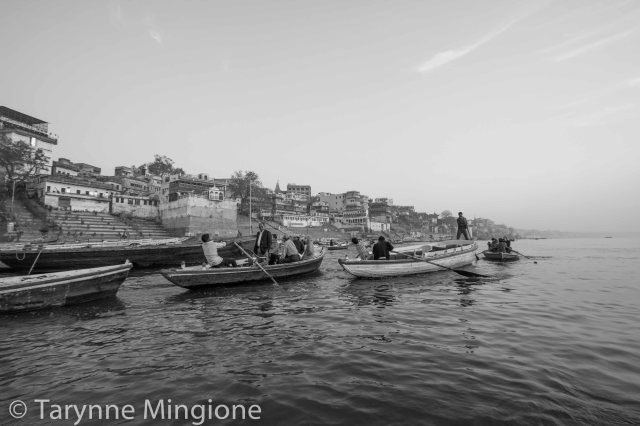


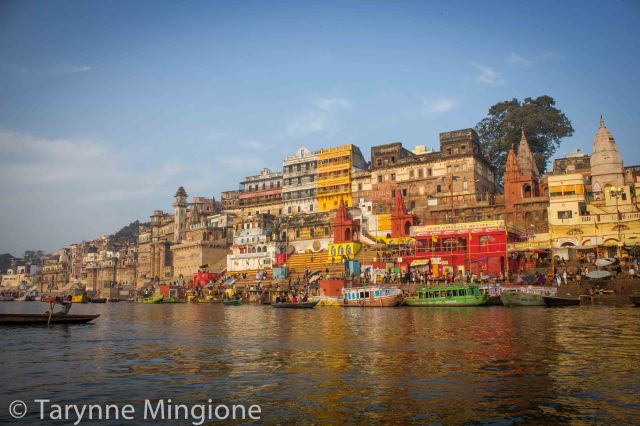










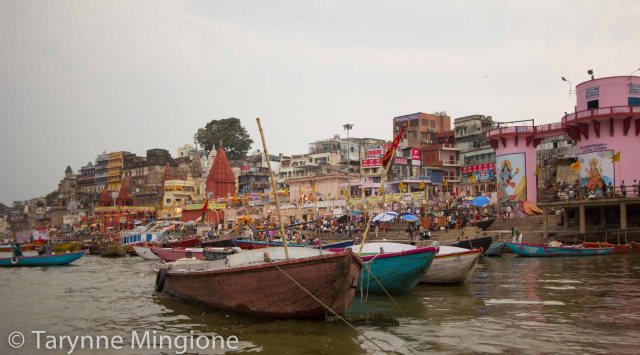
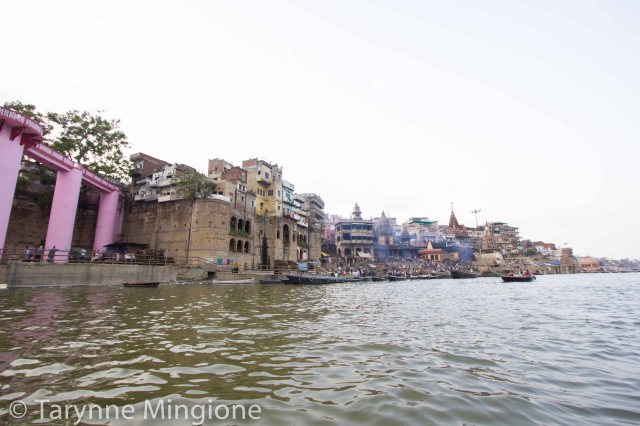
We went from Munshi Ghat down to the main burning ghat. While we were loitering on the Ganga parallel to the burning ghat we had a canoe pass us with a body tethered to a stone slab. The men pushed the body off the boat and retreated back to land. Again, it was such a dry process that I couldn’t help but think about the whole cycle of life long after the body was lost in the Ganga forever.
It was still cloudy so there wasn’t much of a sunset. About 45 minutes into our hour ride the cracking thunder and black clouds in the near distance hinted we should quickly get back to shore. We stuck around Dashaswamedh Ghat for the ganga aarti ceremony which included puja and fire rituals.



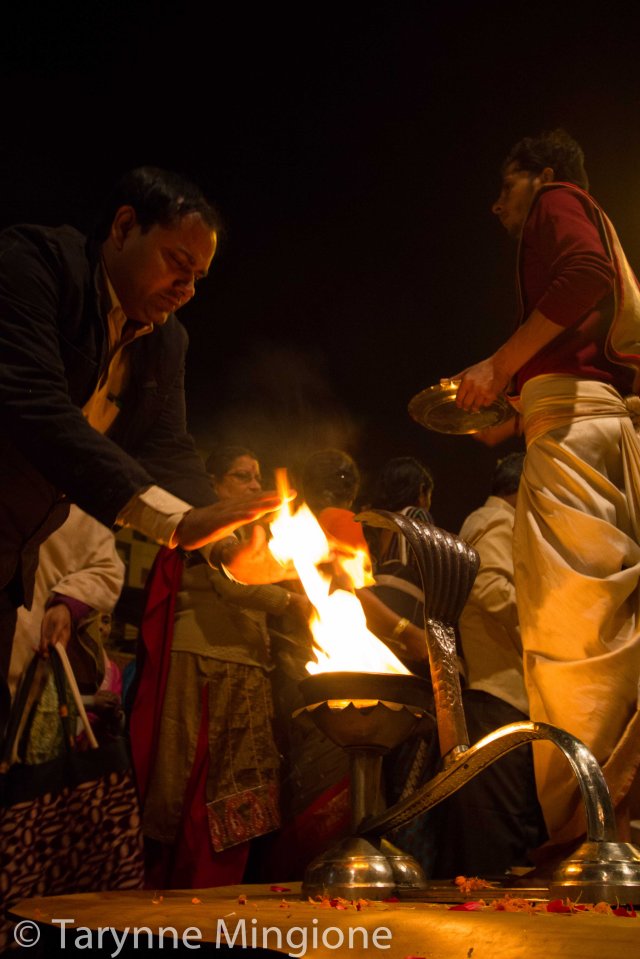



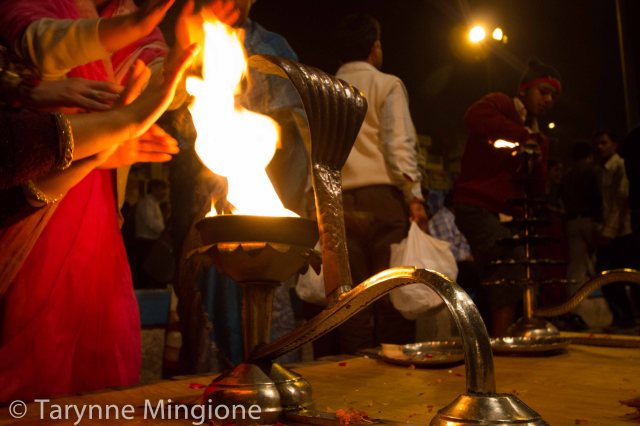

Afterward we headed back to Ganpathi to get a soda and water. Tanveer and Kelly headed out to dinner somewhere else and James and I decided to go on a beer run.
I know I shouldn’t even be revealing this information in this blog, but we just wanted to go grab one beer. We headed to the grittiest shops we could to discreetly ask. We kept getting specific directions and straight faces so we decided to go with it and see where we ended up.
The task to grab a single beer to save 70 rupees ended up taking a good hour and a half. I finally get the sappy quote that says something about “it’s the journey rather than the destination that matters.”



We didn’t give a rip if we ever saw a Kingfisher or not, the whole process was absolutely fun and entertaining. We walked down the craziest streets and eventually ended up at a tiny little cage in the wall. A man was sitting on a box in a window that was about level with our knees from the street. A tiny little hole allowed people to hand off rupees in exchange for liquor.
We asked for beer and the man kindly gave us (again) specific directions for a different place we were unsure actually existed. We were then led down a dark alley and turned a corner into an absolutely pitch black meter wide alleyway.
It sounds ridiculous, but for some reason I felt safe in Varanasi, even while searching for the frowned upon booze in the holy city. I decided to hang back in the little light there was while James disappeared down the alleyway. Three men came out of the alley and asked what I was doing. I wasn’t sure if I should come clean so I managed to carry on conversation with them fibbing my way through until James reappeared proudly chirping about his two beers. I got called out for lying and we all had a good laugh before carrying on toward home, proud of our successful search.
We forgot we were hungry and needed to get food somewhere before going back to the hotel. I know that everyone everywhere says stay far far away from street food in India and for good reason, but we were so sick of Lonely Planet recommendations. They have been wrong more than once and all of the places worth a recommendation have only western tourists consuming food prepared by Kiwi hippies.
Not exactly the cultural and culinary immersion we were hoping for…
James is programmed to my speed-walking pace, so he lost track of me for a minute or two as I became completely mesmerized with the chapatti making in some tiny little street side room. 

The room was once painted royal blue. There was a little circular coal fire, tiny stone slab and some massive aluminum bowls filled with all you need for real Indian thali.
I begged for one chappati and for just 5 rupees got the best chapatti ever in India. We were invited to sit and because they thought the excitement over the one chapatti was pretty funny, gave us another just to watch me do it again.
We ended up ordering thali and I think a half a dozen more chapatti. Once James was finished scraping his plate, the man came over and refilled everything for us. With too much of a language barrier we couldn’t ask if we would be charged double or what just happened so we decided to wait and be surprised for the check at the end.
We walked away paying just 60 rupees for the entire meal.
Ummmm, that is $1. With our Kingfishers stuffed in our pants we laughed and thanked them in absolute disbelief for the incredible meal.
Sunday, March 2, 2014
We had to check out of our luxurious home by 10:00 a.m.
We headed back to the poopey palace, which no longer looked with a refugee camp, and dumped our things before heading back over to setup shop at Ganpathi rooftop restaurant. We did what we do and ordered up a pot of coffee and enjoyed the rooftop for hours.

Eventually we made it down to the ghats and took a walk around before jumping on a boat for over an hour to view the ghats from the Ganga. We had two funny kind hearted guys on the boat and we asked them a hundred questions and they answered them all.
It was peaceful, informative and perfect.







After the boat ride, James went to find a pharmacy because he picked up a nasty cold and I went to run around the rat maze and shoot pics of the madness.



 With my head in my camera I didn’t realize at one point the stream of people walking toward me. I didn’t think much of it because the alleys were always packed and oftentimes lines for temples poured into streets and you would have to tango with dozens of people in order to pass around them.
With my head in my camera I didn’t realize at one point the stream of people walking toward me. I didn’t think much of it because the alleys were always packed and oftentimes lines for temples poured into streets and you would have to tango with dozens of people in order to pass around them.
Well, this one came as a surprise. A stretcher with a body was headed right to where I was standing. I had a temporary freakout when I realized there was nowhere for me to go but hug the wall as closely as I could. Even then I couldn’t avoid having the stretcher brush my shoulder as it passed and was quickly was out of sight.
I met back up with James and we walked down to the main burning ghat. I had the most comical conversation with some local boys about cows and poop while we stood off to the side of the fires.
We wandered through the alleyways before realizing it was 5 p.m. and hadn’t eaten anything all day. We found the rooftop of the Brown Bread Bakery and decided to try something new. Well since there was a heavy German influence I couldn’t get a thing that wasn’t drowning in a slab of butter, cream or ghee. James got a pizza and I got hungry.
We saw the end of the action happening at Dasaswamedh Ghat before heading back to sleep in our caccoons in the former refugee camp.
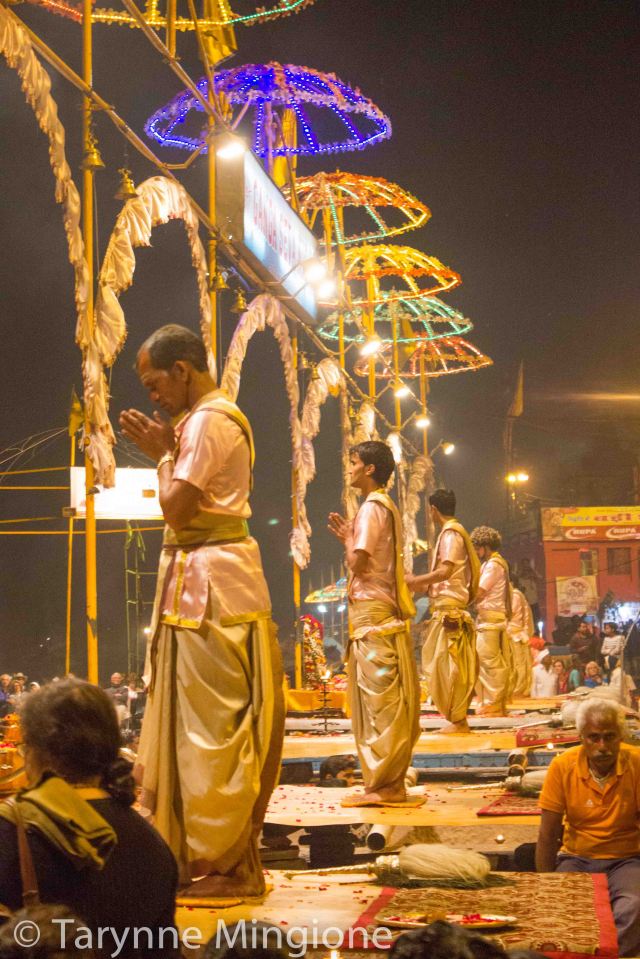

Monday, March 3, 2014
I was up at 6 a.m. and packed my camera gear for a romantic sunrise date with myself. Ha, I’m in India. Who am I kidding? You can’t take a crap without a dozen people joining you.





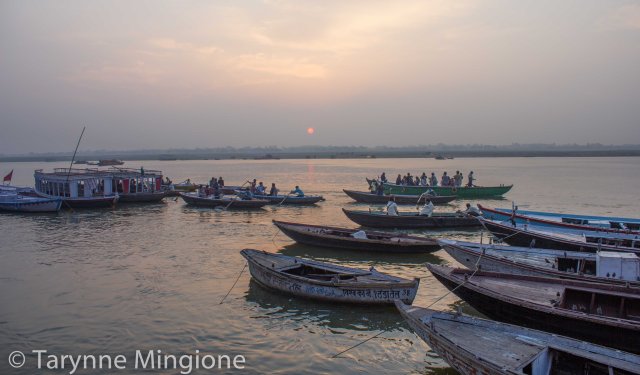





 I walked down to Munshi Ghat and found some friendly babas to hang with. An hour passed and I watched the glowing ball of fire rise on the opposite side of the Ganga. Uncommitted to my sunrise river boat plans, I happily sat on the steps with three babas who’s lives I can never understand, but am curious to. I shared my morning with them until one man invited me to go on a boat ride.
I walked down to Munshi Ghat and found some friendly babas to hang with. An hour passed and I watched the glowing ball of fire rise on the opposite side of the Ganga. Uncommitted to my sunrise river boat plans, I happily sat on the steps with three babas who’s lives I can never understand, but am curious to. I shared my morning with them until one man invited me to go on a boat ride.
I committed to an hour and enjoyed the peaceful flow of the Ganga as we made our way from the Jain ghat to the main burning ghat.
The rest of the morning was spent working on taxes and travel bookings before we headed back to the Ganpathi rooftop for two 40 rupee pots of coffee. We enjoyed the views, potato curry, naan, paneer masala, rice and veggie pakora one last time.
By 3 p.m. we were making the reverse trek through the maze from the river to the main street where we would once again barter for a rickshaw. One hundred rupees later we were dropped at the train station. Our train was at 17:15 and we would make the 24 hour journey to Jodhpur.
We completely lucked out and scored two lower bunks together for the first time! It was 2AC meaning there were bunks above us and at our feet, but it was the sweetest setup we have had on a train so far, and for the Varanasi to Jaipur portion that’s where we camped.
The evening was spent working on photos. We were woken up in the middle of the night by our new bunk mates. The man in the bunk above James stared at me the whole night and I became so uncomfortable that I forfeited the idea of sleep and instead continued to write this blog with a sheet over my head.
Tuesday, March 4, 2014
At noon we jumped off the train and downgraded to general class for the remainder of the journey. It’s not so bad during the day. The windows open so no longer are you forced to smell the urinal scented linens. We we enjoyed the rest of the journey to Jodhpur, the blue city settled smack in the middle of Rajasthan.